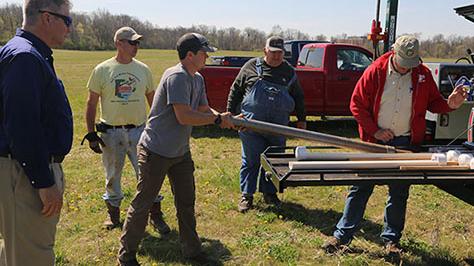Many are familiar with the beautiful grounds of the campus of The Ohio State University at Lima, have walked the paths in the old growth forest remnant, seen water birds stopping over at the wetlands and enjoyed the growing show of biodiversity in the prairie lands.
Fewer eyes turn toward the largest part of the campus – the acres and acres of farmland bordered by Thayer, Reservoir, Mumaugh and Harding Highway. That is about to change.
The agriculture fields are on track to become a very large research project involving faculty and staff from different departments and colleges within Ohio State and looking at regenerative agriculture processes, including the addition of five different cover crops to improve water filtration, organic material, erosion and nutrient distribution, and ultimately, the ability of these fields to help fight climate change.
The fields that have been conventionally tilled for many, many years are about to come under close scrutiny from everyone from soil scientists to physicists and statisticians to biologists and undergraduate researchers.

In addition to the academic pursuits, Ohio State Lima Dean and Director Tim Rehner wants the experiment to give local farmers the chance to see the methods applied without the difficulties of being the first to do it or the trepidation of worrying about the bottom line.
“Since we aren’t really a farmer, we can do it in a learning context and people can talk about us and it’s ok,” Rehner said. “Farming is not our bread and butter. Our bottom line is knowledge – we have a hypothesis and we’re testing it. But farmers have a much different bottom line. If we can demonstrate it working here, it should be replicable elsewhere.”
The campus fields came out of lease about the same time Rehner met long-time regenerative farmer David Brandt on Ohio State’s Roads Scholar tour. The fields were showing signs of erosion and depletion that were unlikely to improve without intervention. Rehner called Brandt up and they formed a plan that has turned into an interdisciplinary project involving many areas of the campus and the community.

Now-former Ohio State Lima board member Todd Mason originally agreed to serve on the committee formed to figure out what to do with the farm. He listened and learned and grew more and more curious. Today, he is the farmer charged with implementing the plan.
“After the first couple of meetings, I learned enough about regenerative agriculture to become really intrigued about the positives it can provide to our soil, climate and financial outcomes,” Mason said. “Knowing the committee needed a local farmer that was in close proximity to the campus that was willing to implement the RA plan, I realized I needed to step up. Being a lifelong Buckeye and being extremely passionate about agriculture made the decision pretty easy once I wrapped my head around it.”
Mason is paying close attention to how the process works and how it can change the inputs necessary to make the farm more productive with less. He knows others in the farming community are paying attention, too, as his alma mater moves forward with a project that can improve things for many parts of the community. He can think of no better place to make the effort.
“We are a land grant university. We need to use this land and the opportunity in front of us to better our community and agriculture” Mason said. “The bottom line here is that we are taking average, at best, quality land and a farmer with average equipment to implement this plan. This is realistic for all farmers out there and hopefully we do some good work to show how we can profitably improve soil health and climate.”

The executive director of Ohio State’s Initiative for Food and AgriCultural Transformation, or InFACT, is also watching the project with great interest. Lima’s efforts to investigate and promote sustainable agriculture that builds the land up dovetails with InFACT’s transdisciplinary efforts to transform the way we grow, process and distribute our food.
“The project in Lima has so much potential from both a short- and longer-term perspective. In the immediate future, the environmental benefits will be highlighted by improved soil health, water quality, biodiversity, and carbon sequestration on those leased lands,” said InFACT’s Brian Snyder. “Down the line, InFACT looks forward to collaborating on other aspects of the project that would bring specific social, economic, and health benefits to the local community as well.”

* * *
Photo from the top
From left: Farmer Todd Mason, soil scientists Steve Baker and Matthew Tucker, farmer David Brandt and retired soil scientist George Derringer take soil bores at Ohio State Lima.
Farmer David Brandt (left) and Dean Tim Rehner (right) examine young peas rooting into the soil.
From left: Farmers Todd Mason and David Brandt discuss soil bore locations with NRCS Soil Scientist Steve Baker.
Farmers Todd Mason and David Brandt talk about regenerative farming as Galvin Hall rises in the distance.
Ohio State Lima from above with the fields marked that will be in the regenerative agriculture project.
Story and photos by Pamela Joseph.

